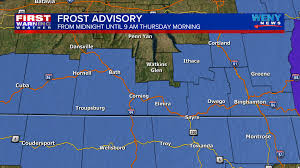Understanding Frost Advisories in Canada

Introduction to Frost Advisories
As the weather cools and autumn transitions to winter, the issuance of frost advisories becomes a significant topic of concern for Canadians. Frost advisories are crucial for protecting crops, managing outdoor activities, and ensuring safety. The impacts of winter temperatures can be widespread, affecting everything from agriculture to transportation.
What is a Frost Advisory?
A frost advisory is issued by Environment and Climate Change Canada when conditions are conducive to frost formation. This typically occurs when the temperature drops to 0 degrees Celsius or lower during the night, often with clear skies and light winds. The advisories serve as warnings to farmers and horticulturists to take preventative measures to shield sensitive plants from potential frost damage.
Recent Events and Weather Patterns
In recent weeks, parts of Canada, including Ontario and Quebec, have experienced several frost advisories due to sudden drops in temperature. According to Environment and Climate Change Canada, average low temperatures are expected to be below the seasonal norm. As nighttime temperatures dip, farmers are mobilizing to protect their crops, covering tender plants and using heaters in greenhouses.
In particular, the impact of these frost advisories has been felt by local agricultural communities. Many farmers have reported losses of early-season crops if they are not adequately prepared for frost. In 2023, the Canadian Agricultural Weather Network recorded notable losses in areas where the advisories went unheeded, emphasizing the need for quick action to minimize frost damage.
Impact on Daily Life
Beyond agriculture, frost advisories also have implications for daily life. Motorists are cautioned to be aware of potentially icy conditions on roads during early mornings, which can pose risks for accidents. Additionally, residents are encouraged to cover their outdoor plants and bring in sensitive outdoor furniture as temperatures during the night can drop rapidly.
Conclusion and Looking Ahead
The significance of frost advisories in Canada cannot be understated as they play a critical role in agriculture and public safety. As the climate continues to change and unpredictable weather patterns emerge, the frequency of frosty mornings may also increase. It is essential for individuals and communities to stay informed and prepared for these advisories to mitigate adverse effects. In the coming months, monitoring temperatures and adhering to advisory alerts will remain vital for safeguarding crops and ensuring safe travel across the country.









